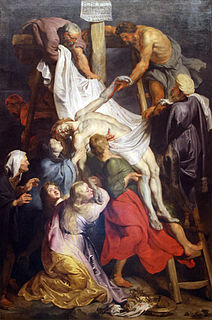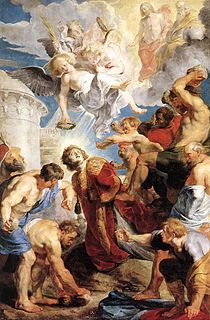 W
WChrist and the Penitent Sinners or Christ with the four great penitents is a 1617 oil painting by Peter Paul Rubens. It is now in the Alte Pinakothek in Munich. It shows Jesus Christ with Mary Magdalene, Saint Peter, Dismas and King David.
 W
WChrist Before the High Priest is a c.1617 oil on canvas painting by Gerard van Honthorst, now in the National Gallery, London, which bought it in 1922.
 W
WThe Descent from the Cross is a painting by Peter Paul Rubens, produced around 1616-1617 for the chapel of the Capuchin convent in Lille. It was seized by France and was part of the founding collection of the Palais des Beaux-Arts de Lille, where it is still housed.
 W
WEntry of Christ into Jerusalem is a 1617 oil painting by Flemish artist Anthony van Dyck, located in the Indianapolis Museum of Art, which is in Indianapolis, Indiana. It depicts Jesus entering Jerusalem as described in the Gospels, the event celebrated on Palm Sunday.
 W
WErichthonius Discovered by the Daughters of Cecrops is a large 1617 oil on canvas painting by Jacob Jordaens, now in the Royal Museum of Fine Arts, Antwerp.
 W
WThe Garden of Eden with the Fall of Man or The Earthly Paradise with the Fall of Adam and Eve is a painting by Peter Paul Rubens (figures) and Jan Brueghel the Elder. It is housed in the Mauritshuis art museum in The Hague, Netherlands. The painting depicts the moment just before the consumption of forbidden fruit and the fall of man.
 W
WThe Great Last Judgement is an oil on canvas altarpiece, painted by the Flemish artist Peter Paul Rubens between 1614 and 1617. He created the composition and final touches and his is the only signature on the work, though it is believed between nine and nineteen studio assistants also worked on it. Its name distinguishes it from the same artist's The Small Last Judgement of 1619 and his The Fall of the Damned of 1620.
 W
WThe Lunch is a very early painting by Spanish artist Diego Velázquez, finished c. 1617. The work, an oil painting on canvas, is in the Hermitage Museum of Saint Petersburg.
 W
WMars and Rhea Silvia is a 1617 painting by Peter Paul Rubens, now in the Liechtenstein Museum in Vienna. It shows Mars's rape of Rhea Silvia, which resulted in the birth of Romulus and Remus, founders of Rome.
 W
WThe Meeting between Abraham and Melchizedek is a 1616-17 painting by Peter Paul Rubens, showing the meeting between Abraham and Melchizedek as recounted in the Genesis 14. It measures 204 cm by 250 cm and is now in the Musée des Beaux-Arts de Caen.
 W
WThe Saint Stephen Triptych is a 1616–1617 oil on panel painting by Peter Paul Rubens, produced as the high altarpiece for Saint-Amand Abbey, a Benedictine house near Valenciennes. It was seized during the French Revolution and is now in the Musée des Beaux Arts de Valenciennes.
 W
WSelf-Portrait as Saint Catherine of Alexandria is a 1615–1617 painting by the Italian Baroque artist Artemisia Gentileschi, showing the artist in the guise of Catherine of Alexandria. It is now in the collection of the National Gallery, London, which purchased it in 2018 for £3.6 million, including about £2.7 million from its American Friends group. It was painted during Gentileschi's time in Florence, and is similar to her Saint Catherine of Alexandria, now in the Uffizi Gallery. It is one of several paintings of female martyrs by Gentileschi that she made after her famous 1612 rape trial, in which her fingers were crushed to force her to tell the truth.
 W
WTwo Women with a Candle or Old Woman and Young Woman with a Candle is a 1616-1617 painting by Peter Paul Rubens, now in the Mauritshuis, The Hague, Netherlands. Its chiaroscuro shows strong influence from Caravaggio, whose work Rubens had seen during a stay in Rome.